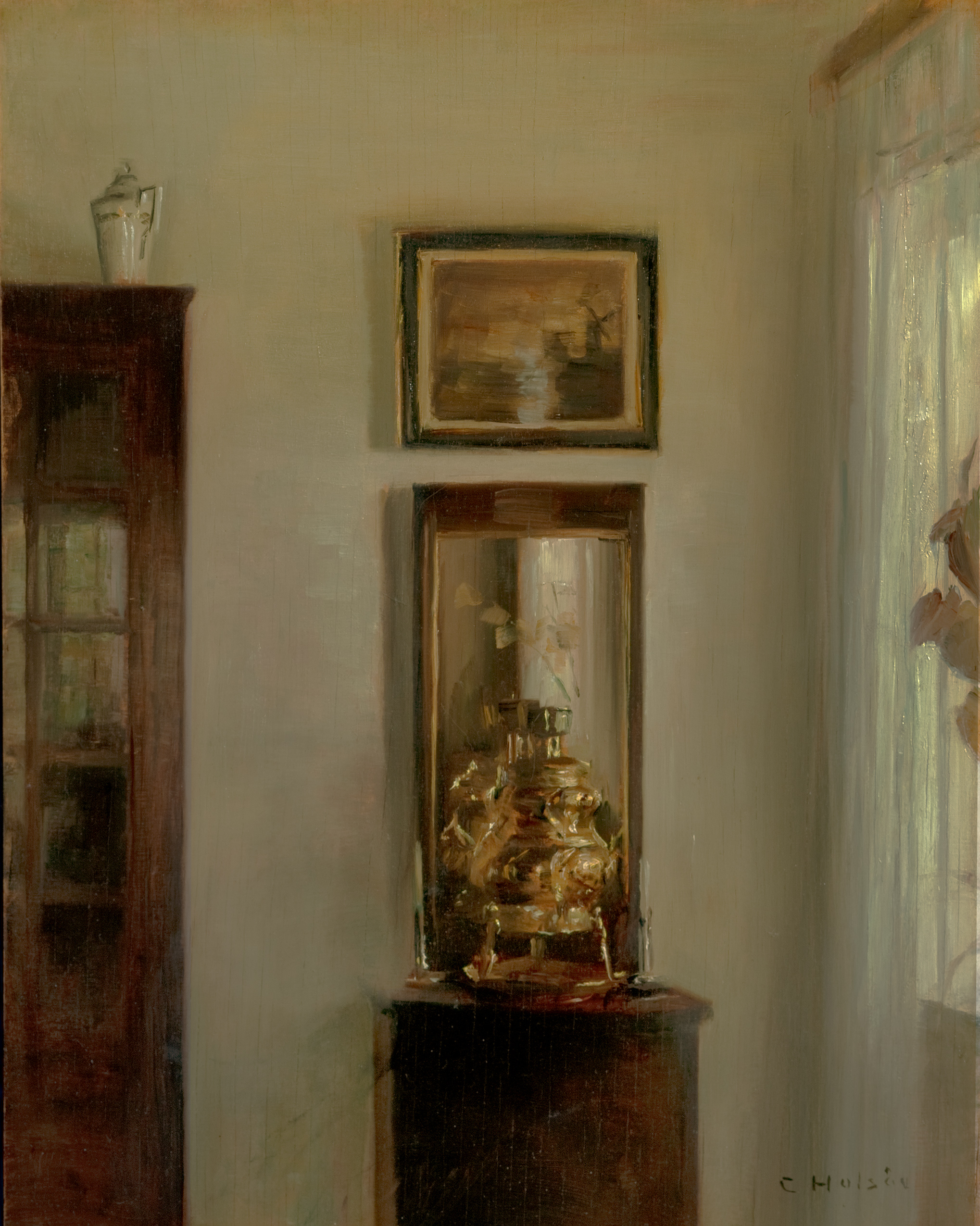CARL VILHELM HOLSOE, Interior with Samovar, Mirror and Dutch Landscape
CARL VILHELM HOLSOE (Aarhus 1863 – Asserbo 1935)
Interior with Samovar, Mirror and Dutch Landscape
signed C. Holsoe in the lower right
oil on panel
15 x 11 3/4 inches (38 x 30 cm)
PROVENANCE
Anonymous sale, Göteborgs Auktionsverk, Goteborg, March 28, 1979, lot 376
Private Collection, Florida, circa 1979 until the present time
Carl Vilhelm Holsoe was born in western Denmark and moved to Copenhagen in 1882 to study at the Kongelige Danke Kunstakademi. In 1884 he attended classes at the Kunstnernes Studieskole under the tutelage of Peder Severin Krøyer.[1] There he would make two lifelong friendships with Peter Ilsted and Vilhelm Hammershoi that would influence the direction of his entire career. Each took as their prime subject matter interior scenes based on their own households creating a genre devoted to “domestic tranquility”.[2] Evocative of the interiors of Dutch seventeenth century masters such as Johannes Vermeer, Pieter de Hooch and Gerrard Terborch, these works struck a chord among their fellow Danes. Holsoe took part in more than 100 exhibitions mainly in Charlottenborg, Copenhagen where he won medals in 1901 and 1908, but also in Paris, 1889 where he received an honorable mention at the Salon; Dusseldorf, 1904; Berlin, 1907; Munich, 1891, 1892, 1901, 1909 and 1913; and London, 1907. He was also awarded a number of study grants to travel, including one to Italy in 1897. The Royal Academy of Denmark’s presentation of the Eckersberg Medal was among the artist’s highest honors. Holsoe’s works can be found in numerous museums throughout Scandinavia. In Denmark these include Göteborg, Odense and the National Gallery of Denmark, Copenhagen. The National Gallery owns one landscape and three interiors with one depicting the artist’s wife Emile Heise. Elsewhere the Thyssen Bornemisza Museum, Madrid and the Neue Pinakothek, Munich possess paintings.[3]
Hammershoi’s and Holsoe’s thematic ties were the closest and it is unclear who first presented interiors. Hammershoi would achieve international recognition while Holsoe pursued a quieter existence out of the spotlight. The main difference between the two is that Holsoe’s works are a more straightforward recording of the quiet intrinsic beauty of interiors, in alignment with the prototypes set by the Dutch masters, while Hammershoi’s atmospheric rooms are more overtly symbolic. Holsoe first exhibited in December, 1886, at Charlottenborg after which the critic Karl Madsen wrote of his Interior that the painting “almost had the character of a manifesto”.[4]
Whether incorporating a figure (usually turned away from the viewer) or not, Holsoe’s commanding power of restraint and lack of narration in his minimally furnished rooms projected a mirror of modernism. Filled with harmonizing color and soft light, featuring few but choice objects strategically placed, the artist embodied the dogma of “less is more” the style preferred by well-to-do Danes of the 1880s and 1890s.[5] In direct opposition to other contemporary aesthetic movements such as that of William Morris, Holsoe embraced the idea that modern homes should evoke the present as opposed to imitating the past. Further a peaceful interior came to be viewed as a refuge from the world, as succinctly stated by the contemporary Belgian critic François Bédarida “Inside meant family and security, outside meant strangers and danger”.[6] During this period the popularity of paintings featuring interior scenes grew in direct proportion to the increasing industrialization and urbanization of Denmark.[7] Although Holsoe painted landscapes interior scenes dominated his output.[8]
The focal point of our Interior is the golden samovar at its center. Reflecting the filtered light from the muslin curtained window to the right it shines incandescently. Placed on a mahogany chest, flanked by silver candlesticks holding white candles, backed by a mirror that replicates the image and topped by a Dutch landscape – the viewer’s attention is captured. Slices of other objects on either side complete the scene. On the right protruding from the window’s ledge are a few delicate purple leaves of a plant. Only via the mirror’s reflection does the plant and window gain further substance. To the left a glass paned wooden cabinet is visible whose single ornament is a porcelain coffee pot. The simplicity of the pot’s design is complemented by the play of light across the glazes of its surface. The cabinet’s paned glass window provides a faint reflection of a seated woman wearing a dark dress facing a sun filled window on the opposite side of the room. The walls are pale grey with cream-colored accents. The employment of a restrained palette, cast shadows and ambient light serve to reinforce the subtlety of the composition. Sun filled windows, mirrors, candlesticks, mahogany furniture, paintings hung symmetrically and solitary figures engaged in contemplative acts were touchstones for Holsoe. The artist’s mastery is evidenced by the timeless serenity created in the simple grouping of a few beautiful objects within this interior.
[1] Rigmore Lovring, “Carl Vilhelm Holsoe” in Grove – The Dictionary of Art, volume 14, Macmillan Publishers
Limited, London, 1996, p. 691.
[2] Patricia G. Berman, Danish Paintings of the Nineteenth Century from the Collection of Ambassador John L.
Loeb, Jr., exhibition catalogue, Bruce Museum of Arts and Science, Greenwich, Connecticut, March 19-June 19,
2005, pp. 62, 108.
[3] Biographical information taken from Thieme-Becker, “Carl Vilhelm Holsøe” in Allgemeines Lexikon der
Bildenden Künstler, volume XVII, Veb. E.A. Seeman Verlag, Leipzig, 1924, pp. 398-399; Lovring, op. cit., p. 691;
and Berman, op. cit., p. 108.
[4] Lovring, op. cit., p. 691.
[5] Kirk Varnedoe, Northern Light Nordic Art at the Turn of the Century, Yale University Press, New Haven, 1988 p.
128; Berman, op. cit., p. 62; Patricia G. Berman, In Another Light: Danish Painting in the Nineteenth Century,
Vendome Press, New York, 2007, p. 250.
[6] Berman, In Another Light, op. cit., p. 244.
[7] Berman, Danish Paintings of the Nineteenth Century, op. cit., p. 27.
[8] Lovring, op. cit., p. 691.
